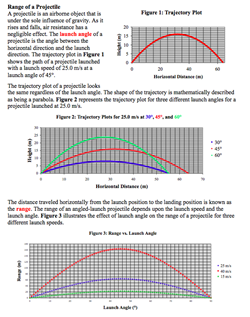 Maximizing the Range of a Projectile
Maximizing the Range of a Projectile
Resource:
Science Reasoning Center: Maximizing the Range of a Projectile
Grade Level: High School
Description:
This passage uses Excel-generated plots to describe the trajectory of a projectile, to compare the trajectories for three different launch angles, and to show the effect of launch angle upon range for three different launch speeds. Questions target a student's ability to read graphical information, to interpolate from graphs, to recognize the effect of one variable on another variable, and to use information presented in graphs to answer related questions.
This activity aligns with the three dimensions of the Next Generation Science Standards in the manner described below:
| Patterns: Empirical evidence is needed to identify patterns. |
When empirical data of an object’s projectile motion are analyzed, relationships emerge and patterns inherent in nature become visible. This exercise in data analysis—one in which students investigate how launch angle and speed affect an object’s range—lead students to see many patterns. One such pattern is that, for a given speed, each launch angle and its complement have the same range. Passages such as this one allow students to come to this understand themselves through the data analysis process. |
| Cause and Effect: Systems can be designed to cause a desired effect. |
Maximizing range, time of flight, and height attained are all authentic projectile motion investigations that have relevance in sports and other aspects of life. To understand what causes produce these desired effects is the focus of this passage. Students build their understanding of such cause and effect relationships in this analysis and can use these results to achieve a desired effect whenever an object is thrown, hit, or launched. |
| Analyzing and Interpreting Data: Analyze data using tools, technologies, and/or models (e.g., computational, mathematical) in order to make valid and reliable scientific claims or determine an optimal design solution. |
All questions posed in this data-rich presentation require the analysis and interpretation of graphs. It is the analysis of such data that will lead students to make claims about the patterns that emerge and the cause and effect relationships that can be found within a projectile’s motion. |
Associated Reading from The Physics Classroom
Other Supporting Pages at The Physics Classroom:
View Infographic.
(Coming Soon)
Search the NGSS Corner
Maybe you're looking for something really specific that pertains to a desired topic and emphasizes one or more of the listed NGSS dimensions. Why not try a search of this section of our website? Simply select from one or more of the pull-down menus and click Search This page will reload and a collection of possibilities will be displayed in this section of the page and sorted by relevancy.